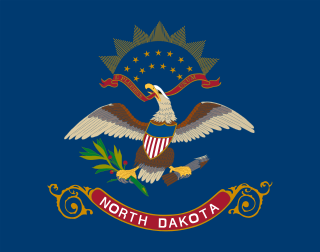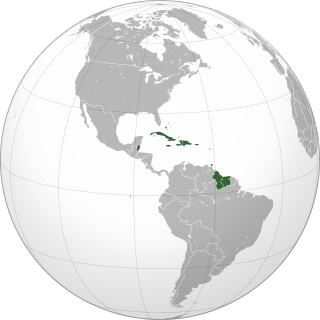
The Atlantic Ocean is the second largest of the world's oceans, with an area of about 106,460,000 square kilometers. It covers approximately 20 percent of Earth's surface and about 29 percent of its water surface area. It separates the "Old World" from the "New World".

The American Civil War was a civil war in the United States from 1861 to 1865, fought between the northern United States and the southern United States. The civil war began primarily as a result of the long-standing controversy over the enslavement of black people. War broke out in April 1861 when secessionist forces attacked Fort Sumter in South Carolina shortly after Abraham Lincoln had been inaugurated as the President of the United States. The loyalists of the Union in the North, which also included some geographically western and southern states, proclaimed support for the Constitution. They faced secessionists of the Confederate States in the South, who advocated for states' rights in order to uphold slavery.
American English, sometimes called United States English or U.S. English, is the set of varieties of the English language native to the United States. Currently, American English is the most influential form of English worldwide.

The Confederate States of America —commonly referred to as the Confederacy—was an unrecognized republic in North America that existed from 1861 to 1865. The Confederacy was originally formed by seven secessionist slave-holding states—South Carolina, Mississippi, Florida, Alabama, Georgia, Louisiana, and Texas—in the Lower South region of the United States, whose economy was heavily dependent upon agriculture, particularly cotton, and a plantation system that relied upon the labor of African-American slaves. Convinced that the institution of slavery was threatened by the November 1860 election of Republican candidate Abraham Lincoln to the U.S. presidency on a platform which opposed the expansion of slavery into the western territories, the Confederacy declared its secession in rebellion against the United States, with the loyal states becoming known as the Union during the ensuing American Civil War. Confederate Vice President Alexander H. Stephens described its ideology as being centrally based "upon the great truth that the negro is not equal to the white man; that slavery, subordination to the superior race, is his natural and normal condition".

The Korean War was a war between North Korea and South Korea. The war began on 25 June 1950 when North Korea invaded South Korea.

North America is a continent entirely within the Northern Hemisphere and almost all within the Western Hemisphere. In can also be described as a northern subcontinent of the Americas in models that use fewer than seven continents. It is bordered to the north by the Arctic Ocean, to the east by the Atlantic Ocean, to the west and south by the Pacific Ocean, and to the southeast by South America and the Caribbean Sea.

Native Americans, also known as American Indians, Indigenous Americans and other terms, are the indigenous peoples of the United States, except Hawaii and territories of the United States. More than 570 federally recognized tribes live within the US, about half of which are associated with Indian reservations. The term "American Indian" excludes Native Hawaiians and some Alaskan Natives, while "Native Americans" are American Indians, plus Alaska Natives of all ethnicities. The US Census does not include Native Hawaiians or Chamorro, instead being included in the Census grouping of "Native Hawaiian and other Pacific Islander".

North Carolina is a U.S. state located in the southeastern region of the United States. North Carolina is the 28th largest and 9th-most populous of the 50 United States. It is bordered by Virginia to the north, the Atlantic Ocean to the east, Georgia and South Carolina to the south, and Tennessee to the west. Raleigh is the state's capital and Charlotte is its largest city. The Charlotte metropolitan area, with an estimated population of 2,569,213 in 2018, is the most populous metropolitan area in North Carolina, the 23rd-most populous in the United States, and the largest banking center in the nation after New York City. The Raleigh metropolitan area is the second-largest metropolitan area in the state, with an estimated population of 1,362,540 in 2018, and is home to the largest research park in the United States, Research Triangle Park.

North Dakota is a U.S. state in the midwestern and northern regions of the United States. It is the nineteenth largest in area, the fourth smallest by population, and the fourth most sparsely populated of the 50 states. North Dakota was admitted to the Union on November 2, 1889, along with its neighboring state, South Dakota. Its capital is Bismarck, and its largest city is Fargo.

The Americas comprise the totality of the continents of North and South America. Together, they make up most of the land in Earth's western hemisphere and comprise the New World.

The Vietnam War, also known as the Second Indochina War, and in Vietnam as the Resistance War Against America or simply the American War, was a conflict in Vietnam, Laos, and Cambodia from 1 November 1955 to the fall of Saigon on 30 April 1975. It was the second of the Indochina Wars and was officially fought between North Vietnam and South Vietnam. North Vietnam was supported by the Soviet Union, China, and other communist allies; South Vietnam was supported by the United States, South Korea, the Philippines, Australia, Thailand and other anti-communist allies. The war, considered a Cold War-era proxy war by some, lasted 19 years, with direct U.S. involvement ending in 1973, and included the Laotian Civil War and the Cambodian Civil War, which ended with all three countries becoming communist in 1975.

The Thirteen Colonies, also known as the Thirteen British Colonies or the Thirteen American Colonies, were a group of colonies of Great Britain on the Atlantic coast of America founded in the 17th and 18th centuries which declared independence in 1776 and formed the United States of America. The Thirteen Colonies had very similar political, constitutional, and legal systems, and were dominated by Protestant English-speakers. The northern colonies were founded primarily for religious reasons, while the southern colonies were founded for financial profit and business expansion. All thirteen were part of Britain's possessions in the New World, which also included colonies in Canada, Florida, and the Caribbean.

Charlotte is the most populous city in the U.S. state of North Carolina. Located in the Piedmont, it is the county seat of Mecklenburg County. In 2018, the U.S. Census Bureau estimated the population was 872,498, making it the 16th-most populous city in the United States. The city is the cultural, economic, and transportation center of the Charlotte metropolitan area, whose population ranks 23rd in the U.S., and had a population of 2,569,213, in 2018. The Charlotte metropolitan area is part of a sixteen-county market region or combined statistical area with a 2018 census-estimated population of 2,728,933.

The Southern United States, also known as the American South or simply the South, is a geographic and cultural region of the United States. It is located between the Atlantic Ocean and the Western United States, with the Midwestern United States and Northeastern United States to its north and the Gulf of Mexico and Mexico to its south.

The North American Central Time Zone (CT) is a time zone in parts of Canada, the United States, Mexico, Central America, some Caribbean Islands, and part of the Eastern Pacific Ocean.

The indigenous peoples of the Americas are the pre-Columbian peoples of North, Central and South America and their descendants.

The West Indies is a region of the North Atlantic Ocean and the Caribbean that includes the island countries and surrounding waters of three major archipelagos: the Greater Antilles, the Lesser Antilles, and the Lucayan Archipelago.

The CONCACAF Champions League is an annual continental club football competition organized by CONCACAF for the top football clubs in North America, Central America, and the Caribbean. The winner of the CONCACAF Champions League automatically qualifies for the quarter-finals of the FIFA Club World Cup. The tournament has officially been known as the Scotiabank CONCACAF Champions League since February 2015 to reflect Scotiabank's sponsorship. The competition has been completed 54 times through the 2019 event, with 56 champions due to a three-way shared title in the 1978 competition.

The Caribbean is a region of the Americas that consists of the Caribbean Sea, its islands and the surrounding coasts. The region is southeast of the Gulf of Mexico and the North American mainland, east of Central America, and north of South America.

A continent is one of several very large landmasses. Generally identified by convention rather than any strict criteria, up to seven regions are commonly regarded as continents geopolitically. Ordered from largest in area to smallest, these seven regions are: Asia, Africa, North America, South America, Antarctica, Europe, and Australia. Schemes with fewer continents may merge some of these, for example some systems include Eurasia or America as single continents.


















